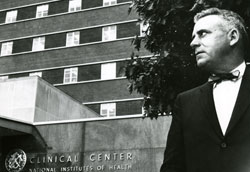On July 1, 1968 President Lyndon Johnson issued an Executive Order establishing the John E. Fogarty International Center for Advanced Study in the Health Sciences at the National Institutes of Health. For more than 50 years, support for Fogarty's
international research and research training programs has grown from its first year budget of $500,000 to its current level of $81 million for fiscal year 2020. The Center's research, training and capacity-building enterprise extends to over 100 countries and involves some 5,000 scientists in the U.S. and abroad.
Learn more about the
history of the Fogarty International Center in the NIH Almanac.
About Rep. John Edward Fogarty (1913–1967)
 Photo courtesy of the Fogarty family
Photo courtesy of the Fogarty family
Decades before phrases like "globalization" and "multiculturalism" became commonplace, Rep. John Edward Fogarty (D-RI) advocated for international health research to reduce suffering and foster peace and prosperity throughout the world. Over the course of his 27 years in Congress, Fogarty was a champion for NIH and for the value of medical research. During his tenure as Chair of the Appropriations Subcommittee with responsibility for health funding, the budget for NIH grew from $37 million in 1949 to $1.24 billion in 1967.
Over the years, Fogarty repeatedly, but unsuccessfully, argued for the creation of an international health research institute to promote the study of global health problems. His sudden death of a heart attack on January 10, 1967, provided the catalyst that finally brought his "Health for Peace" center into existence in July 1968.
Since then, the John E. Fogarty International Center has assumed a prominent place in the global health community, funding research and building sustainable research capacity at home and abroad.
To view Adobe PDF files,
download current, free accessible plug-ins from the Adobe's website.
Updated July 2020